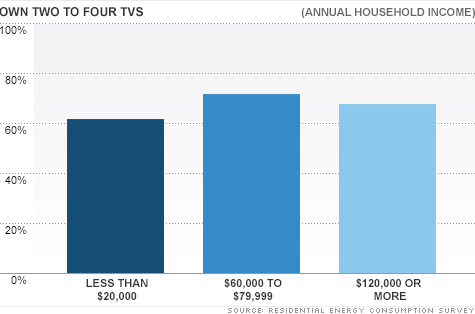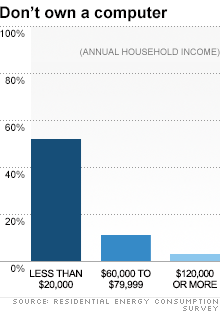Search News

Low-income consumers own almost nearly as many televisions as middle-class and wealthy Americans.
NEW YORK (CNNMoney) -- Can you really be poor if you own a flat-screen TV ... or two? Depends on whom you ask.
With income inequality at the center of the national political debate this year, it should be no surprise that conservatives and liberals are coming down on opposite sides of the tracks.
 |
| Income does seem to matter when buying a PC. More than half the nation's poor do not own a computer. |
Conservatives point to spending patterns, saying consumption is a better indicator of living standards than income. Using that metric, the nation's poor are living better than they have been in decades, enjoying many of the amenities that the middle class have.
"People are not as badly off as you think," said Aparna Mathur, resident scholar at the American Enterprise Institute, a right-leaning organization.
Liberals, however, counter by saying that while electronics and appliances have become more affordable, basic necessities such as child care, health care and transportation have not. These costs have left the poor struggling to make ends meet.
There's little argument that modern amenities have worked their way into most Americans' homes.
For instance, some 62% of households earning less than $20,000 annually owned between two and four televisions, according to the 2009 Residential Energy Consumption Survey, conducted by the U.S. Energy Information Agency. That compares to 68% of those earning $120,000 or more.
About one-third of the lowest income households had either LCD or plasma TVs. Granted, that's less than half the share of the highest income group, but conservative researchers say it's a sign that the consumption gap is narrowing.
Mathur also points to other appliances and electronics that are now commonplace in the homes of those with the lowest incomes, including microwaves and air conditioning.
"This is not what you think of when you think of poverty," she said. "The fact that people can afford these things suggests improvement in living standards over time."
Concerns about rising income inequality, falling wages and growing poverty have been in the spotlight over the past year. The Occupy Wall Street movements of last fall brought them to the world's attention, while the 2012 presidential campaign has kept them in the national dialogue.
Still, the improvement in living standards cited by conservative researchers is likely due to three factors. Prices for many appliances and electronics have dropped significantly, making them less expensive for everyone.
Also, during the boom times before the Great Recession, many Americans loaded up on debt to finance purchases and keep up with their neighbor's lifestyles.
Finally, government policies, including tax credits, put more money in the hands of lower-income families, Mathur said.
To be sure, gaps still exist and modern conveniences aren't universal in poor homes. For instance, 52% of the lowest income families lack a computer, compared to just 3% of the highest income homes. Some 69% of the poorest households don't use a dishwasher, but only 10% of the richest lack this amenity.
Several conservative researchers, however, say that Americans don't have a true idea of what living in poverty means.
The average household defined as "poor" in 2005 had air conditioning, cable TV and a DVD player, according to government statistics cited by Robert Rector, a senior research fellow at the Heritage Foundation. If there were children in the home, the family likely had a game system, such as a Microsoft (MSFT, Fortune 500) Xbox or Sony (SNE) PlayStation.
Poor Americans had more living space than average Europeans and were not hungry, Rector said.
"If you took the typical poor household and put them on TV, no one would think they are poor," he said. "They struggle to make ends meet, but they are not in any type of deprivation."
Advocates for low-income consumers say there's no doubt that poverty today is different than what it was a century ago, when being poor often meant lacking conveniences most Americans now take for granted.
Cell phones, for example, are essential, especially for those who are working or looking for employment. Many of these devices also are relatively affordable.
"We have a new standard of living, but it's not a sign of luxury," said Jodie Levin-Epstein, deputy director of CLASP, which advocates for the poor.
Also, TVs and dishwashers aren't what's breaking the backs of the poor. Instead, they are locked into poverty by the rising cost of work-related expenses, such as child care and transportation, or medical charges.
"Technology is getting much cheaper, but the cost of basics is really putting pressure on family budgets," said Melissa Boteach, director of the Poverty to Prosperity program at the Center for American Progress. ![]()
| Overnight Avg Rate | Latest | Change | Last Week |
|---|---|---|---|
| 30 yr fixed | 3.80% | 3.88% | |
| 15 yr fixed | 3.20% | 3.23% | |
| 5/1 ARM | 3.84% | 3.88% | |
| 30 yr refi | 3.82% | 3.93% | |
| 15 yr refi | 3.20% | 3.23% |
Today's featured rates:
| Latest Report | Next Update |
|---|---|
| Home prices | Aug 28 |
| Consumer confidence | Aug 28 |
| GDP | Aug 29 |
| Manufacturing (ISM) | Sept 4 |
| Jobs | Sept 7 |
| Inflation (CPI) | Sept 14 |
| Retail sales | Sept 14 |